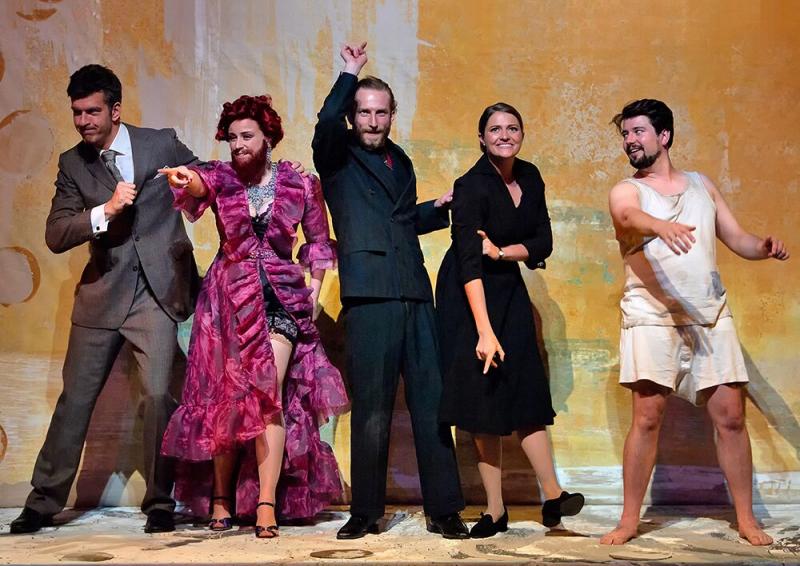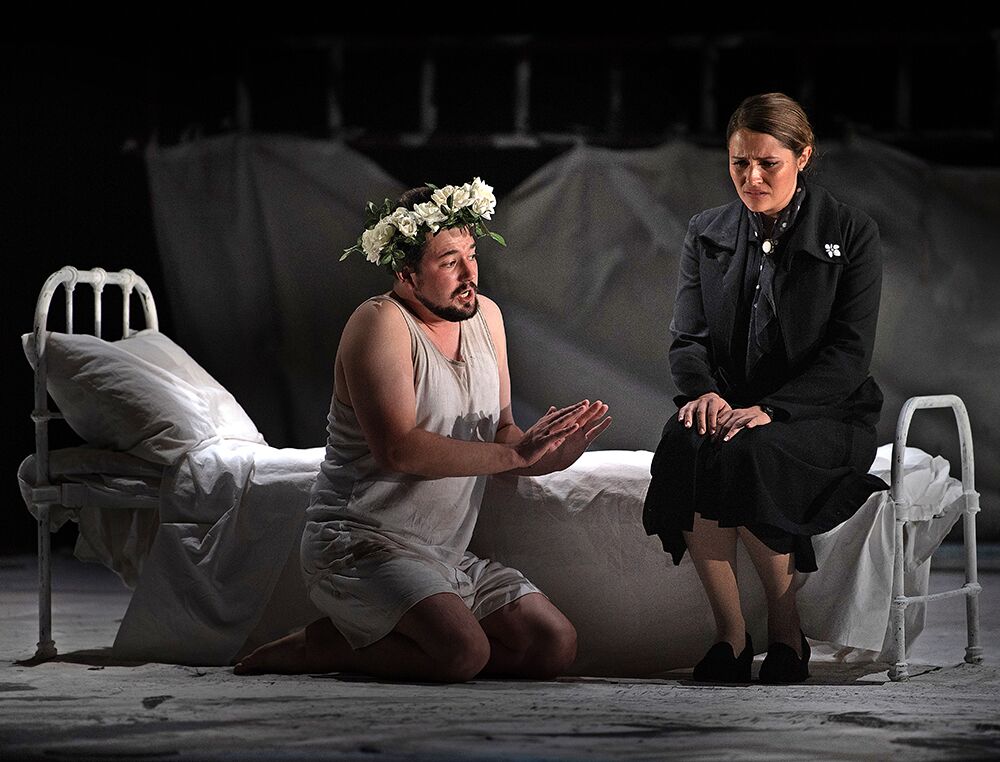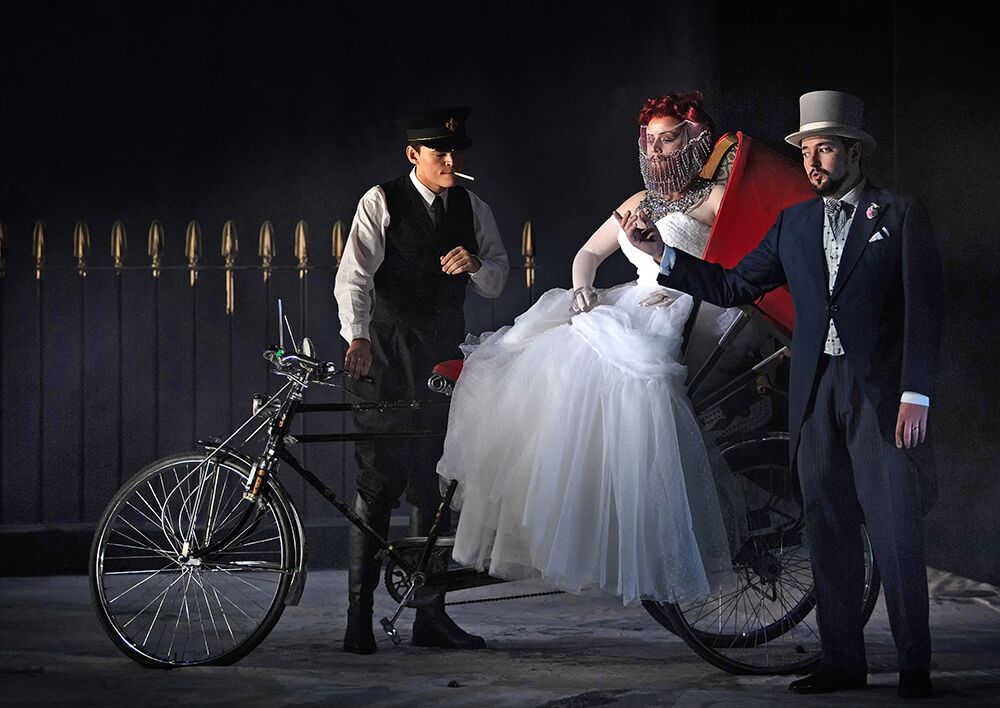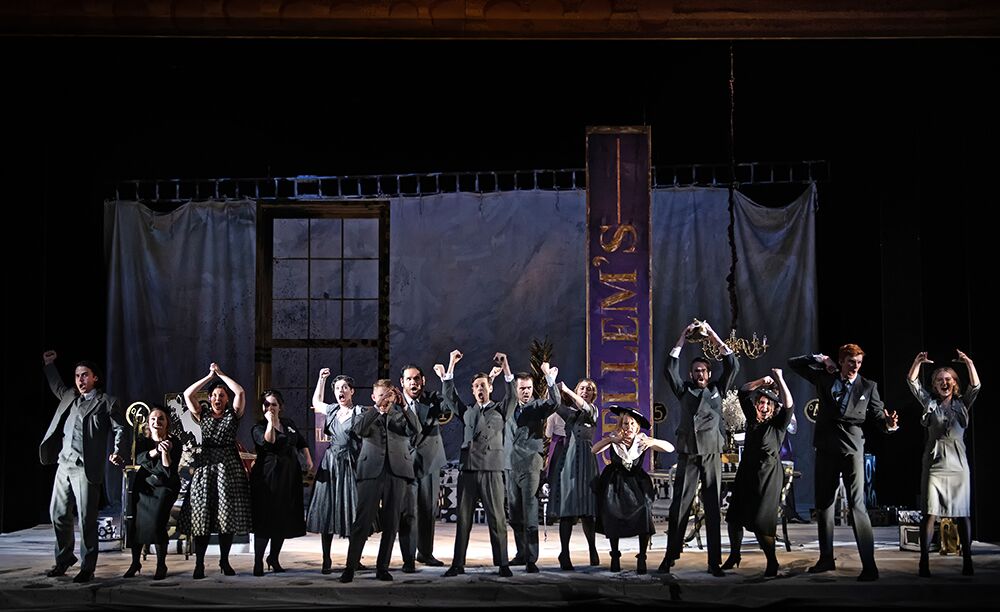The Rake's Progress, British Youth Opera review - perfect poise in slippery Stravinsky | reviews, news & interviews
The Rake's Progress, British Youth Opera review - perfect poise in slippery Stravinsky
The Rake's Progress, British Youth Opera review - perfect poise in slippery Stravinsky
Well-trained young singers have space to articulate skewed morality tale

So it's been sellouts for half-baked if well-cast productions of The Rake's Progress and now Britten's Paul Bunyan at Wilton's Music Hall, while British Youth Opera's classy Stravinsky in the admittedly larger Peacock Theatre, several hundred yards away from the Hogarth Rake paintings in Sir John Soane's Museum, played to a half-empty house, last night, at least.
The set-up of a company carefully organised to give young singers and players (of the Southbank Sinfonia) maximum preparation from experienced professional staff is certainly doing its job both here and in the 18th century pasticcio The Enchanted Island if reports of that tell true. It's true that the sounds from the pit are a little careful under BYO Music Director Lionel Friend (good lord, it was he who conducted the first opera I ever saw, La Traviata at ENO in the late 1970s). One day they'll take the risk of a fiery young conductor. But this way, given Friend's eagle eye, the singers can feel secure in their incredibly meaningful and accomplished delivery of the wickedly off-kilter way Stravinsky sometimes sets his great librettists' lines.  That goes for everybody, from the three singers in the taxing main roles of Good (Anne Trulove), Evil (Nick Shadow) and the weak-willed, easily poisoned victim caught in between (Tom Rakewell) down to fine vignettes from Iain Henderson as auctioneer Sellem and even Thomas Mole as Madhouse Keeper. Samantha Clarke's Anne (picture above with Frederick Jones in the Bedlam scene) could be seen and heard in any of the world's opera houses right now. Her sympathetic facial expressions tell us everything we know, the lyric soprano seems effortless, and there's strength of purpose here (Anne, like Micaela and Pamina, is no pale good girl as she dares all to help her wayward sweetheart; in our poets' marvellously simple words for her, "If love be love, it will not alter/falter").
That goes for everybody, from the three singers in the taxing main roles of Good (Anne Trulove), Evil (Nick Shadow) and the weak-willed, easily poisoned victim caught in between (Tom Rakewell) down to fine vignettes from Iain Henderson as auctioneer Sellem and even Thomas Mole as Madhouse Keeper. Samantha Clarke's Anne (picture above with Frederick Jones in the Bedlam scene) could be seen and heard in any of the world's opera houses right now. Her sympathetic facial expressions tell us everything we know, the lyric soprano seems effortless, and there's strength of purpose here (Anne, like Micaela and Pamina, is no pale good girl as she dares all to help her wayward sweetheart; in our poets' marvellously simple words for her, "If love be love, it will not alter/falter").
Frederick Jones as Tom could do with more colour in the voice, but has plenty of musicality and meaning, and is probably technically speaking the best protagonist I've heard in the role; the tricky top notes hold no fear for him. So yet another useful young tenor on the books. There's plenty of focused energy, too, from Sam Carl's Nick Shadow, especially good when the sartorial mask falls in the graveyard claiming of Tom's soul.  Jessica Ouston (pictured above as Baba stepping from her "sedan") is the only one who needs to work a bit harder on the words – more consonants, please – in Baba's catalogue of her curiosities, but comes energetically into focus in her rage cabaletta, husband-beating included. Her maternal advice to Anne in the auction scene, delivered sitting cross-legged and confidentially, was one of the two points which moved me to tears (the Bedlam scene nearly always does, the more so given Stravinsky's classical-masque restraint).
Jessica Ouston (pictured above as Baba stepping from her "sedan") is the only one who needs to work a bit harder on the words – more consonants, please – in Baba's catalogue of her curiosities, but comes energetically into focus in her rage cabaletta, husband-beating included. Her maternal advice to Anne in the auction scene, delivered sitting cross-legged and confidentially, was one of the two points which moved me to tears (the Bedlam scene nearly always does, the more so given Stravinsky's classical-masque restraint).
All these singers have been trained to use their hands and arms meaningfully to inform the text. The clarity is familiar from director Stephen Unwin's simple but effective English Touring Theatre Shakespeare (unforgettable Henry IV plays with Timothy West as the best Falstaff I've seen and son Sam as Hal). Just how much hard work has been done by movement director Natasha Harrison becomes evident in the sparky choruses, a perfect balance between stylisation and free motion in between.  The ensemble works superbly in the clutter-free space designed by James Cotterill. Was it as wry mock-competition with the classic Hockney Rake first seen at Glyndebourne that the late Howard Hodgkin is the reference point? His splodges stylishly inform the gilded frame, a drop cloth variously and effectively lit by Mark Jonathan and the various colour-schemes through the opera's nine scenes, the spattered hanging at the back gradually falling to strip away all theatrical illusion in the final madhouse ritual. The period is loosely, but not obtrusively, 1950s. There are no radical comments on an already rich piece of music-theatre, but for once there don't need to be. The singers and their understanding of words and music always come first.
The ensemble works superbly in the clutter-free space designed by James Cotterill. Was it as wry mock-competition with the classic Hockney Rake first seen at Glyndebourne that the late Howard Hodgkin is the reference point? His splodges stylishly inform the gilded frame, a drop cloth variously and effectively lit by Mark Jonathan and the various colour-schemes through the opera's nine scenes, the spattered hanging at the back gradually falling to strip away all theatrical illusion in the final madhouse ritual. The period is loosely, but not obtrusively, 1950s. There are no radical comments on an already rich piece of music-theatre, but for once there don't need to be. The singers and their understanding of words and music always come first.
The future of Arts Journalism
You can stop theartsdesk.com closing!
We urgently need financing to survive. Our fundraising drive has thus far raised £49,000 but we need to reach £100,000 or we will be forced to close. Please contribute here: https://gofund.me/c3f6033d
And if you can forward this information to anyone who might assist, we’d be grateful.

Subscribe to theartsdesk.com
Thank you for continuing to read our work on theartsdesk.com. For unlimited access to every article in its entirety, including our archive of more than 15,000 pieces, we're asking for £5 per month or £40 per year. We feel it's a very good deal, and hope you do too.
To take a subscription now simply click here.
And if you're looking for that extra gift for a friend or family member, why not treat them to a theartsdesk.com gift subscription?
more Opera
 La bohème, Opera North review - still young at 32
Love and separation, ecstasy and heartbreak, in masterfully updated Puccini
La bohème, Opera North review - still young at 32
Love and separation, ecstasy and heartbreak, in masterfully updated Puccini
 Albert Herring, English National Opera review - a great comedy with depths fully realised
Britten’s delight was never made for the Coliseum, but it works on its first outing there
Albert Herring, English National Opera review - a great comedy with depths fully realised
Britten’s delight was never made for the Coliseum, but it works on its first outing there
 Carmen, English National Opera review - not quite dangerous
Hopes for Niamh O’Sullivan only partly fulfilled, though much good singing throughout
Carmen, English National Opera review - not quite dangerous
Hopes for Niamh O’Sullivan only partly fulfilled, though much good singing throughout
 Giustino, Linbury Theatre review - a stylish account of a slight opera
Gods, mortals and monsters do battle in Handel's charming drama
Giustino, Linbury Theatre review - a stylish account of a slight opera
Gods, mortals and monsters do battle in Handel's charming drama
 Susanna, Opera North review - hybrid staging of a Handel oratorio
Dance and signing complement outstanding singing in a story of virtue rewarded
Susanna, Opera North review - hybrid staging of a Handel oratorio
Dance and signing complement outstanding singing in a story of virtue rewarded
 Ariodante, Opéra Garnier, Paris review - a blast of Baroque beauty
A near-perfect night at the opera
Ariodante, Opéra Garnier, Paris review - a blast of Baroque beauty
A near-perfect night at the opera
 Cinderella/La Cenerentola, English National Opera review - the truth behind the tinsel
Appealing performances cut through hyperactive stagecraft
Cinderella/La Cenerentola, English National Opera review - the truth behind the tinsel
Appealing performances cut through hyperactive stagecraft
 Tosca, Royal Opera review - Ailyn Pérez steps in as the most vivid of divas
Jakub Hrůša’s multicoloured Puccini last night found a soprano to match
Tosca, Royal Opera review - Ailyn Pérez steps in as the most vivid of divas
Jakub Hrůša’s multicoloured Puccini last night found a soprano to match
 Tosca, Welsh National Opera review - a great company reduced to brilliance
The old warhorse made special by the basics
Tosca, Welsh National Opera review - a great company reduced to brilliance
The old warhorse made special by the basics
 BBC Proms: The Marriage of Figaro, Glyndebourne Festival review - merriment and menace
Strong Proms transfer for a robust and affecting show
BBC Proms: The Marriage of Figaro, Glyndebourne Festival review - merriment and menace
Strong Proms transfer for a robust and affecting show
 BBC Proms: Suor Angelica, LSO, Pappano review - earthly passion, heavenly grief
A Sister to remember blesses Puccini's convent tragedy
BBC Proms: Suor Angelica, LSO, Pappano review - earthly passion, heavenly grief
A Sister to remember blesses Puccini's convent tragedy
 Orpheus and Eurydice, Opera Queensland/SCO, Edinburgh International Festival 2025 review - dazzling, but distracting
Eye-popping acrobatics don’t always assist in Gluck’s quest for operatic truth
Orpheus and Eurydice, Opera Queensland/SCO, Edinburgh International Festival 2025 review - dazzling, but distracting
Eye-popping acrobatics don’t always assist in Gluck’s quest for operatic truth
